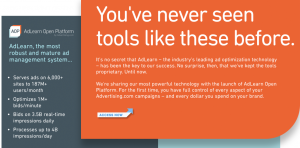How AOL, Google And Yahoo Are Jockeying For Larger Brand Budgets
by on 12th Feb 2014 in News

The race to woo further lucrative brand advertising budgets to programmatic channels continues to heat up, with Google striking a deal with ComScore to improve real-time campaign measurement data, as the resurgent AOL commits to opening more premium ad inventory to third parties.
Google and ComScore yesterday (11 February) announced a deal to give advertisers improved real-time insight into how ad campaigns booked on its DoubleClick ad platform are performing across screens.
The deal will see Google integrating Comscore’s Validated Campaign Essentials (vCE) ad measurement product into its DoubleClick offering, which improves advertisers ability to optimise campaigns as they happen.
ComScore’s vCE metric tool will be built directly into the DoubleClick ad server that publishers and marketers use to deliver their ads and will be initially made available in the US, before a further roll out.
Both parties will then jointly seek Media Rating’s Council (MRC) accreditation for the service following the full roll out of the service. At launch a host of advertisers and publishers (including Kellogg’s, Starcom MediaVest, as well as Conde Nast) have come out with vocal support for the initiative.
AOL Promises Further Premium Ad Inventory
The news of the launch comes as AOL promises to commit further premium inventory to advertisers booking campaigns via its programmatic channels, in the wake of its most promising financial filing in the last ten years.
Buoyed by the news that 2013 was AOL’s most successful year in the last decade, the US firm is touting its programmatic and premium inventory offering as a unique selling point, even citing it as an edge over search giant Google, in the upper tiers of the market.
ExchangeWire caught up with Noel Penzer, AOl UK MD, to discuss how the company is using its multi-billion dollar purchase spree – a strategy that dates back over four years – to engineer the upward trajectory in its fortunes.
And key to AOL’s further growth strategy is its planned further cooperation with agency trading desks, using its AdLearn Open platform to increase the amount of premium inventory available to advertisers, Penzer maintains.
AOL reported revenues of $679m for Q4, 2013 (representing a 23% annual increase) and full year revenues of $1.6bn (representing a 14% year-on-year increase) last week, with its programmatic offering cited as a major contributor to this performance.
Display ad revenues for the quarter grew 7% year-on-year to $181.7m, offsetting a 2% annual decrease in search revenues, and its third-party ad network revenues soared by 63% year-on-year to $223.6m. However, this was surpassed by revenues from ad revenues generated by AOL properties, which rose 4% year-on-year to hit $283.4m during the quarter.
Speaking with ExchangeWire, Penzer explains how the increase in its programmatic offering – which was augmented most recently by $405m of video ad firm Adap.tv and content personalisation firm Gravity – is winning over media buyers.
He says: “This was the most successful period in over a decade with growth in revenues, profits, traffic and user engagement. This included the biggest revenue growth in over ten years.”
Penzer goes on to state that the company’s “barbell strategy” – one that aims to attract both high-end brand budgets as well more long-tail performance dollars with programmatic placements – is paying off.
He explains: “Both the premium content and programmatic side of the offering seems to be working. We’ve got content such as The Huffington Post, and now with offerings such as Adapt.tv – it’s a bit too early to talk about our purchase of Gravity – they’re both paying off."
“With .4.3 billion ads served [in December 2013] and 55% of our campaigns cross-screen we’re one of the biggest in the market.”
When asked what gives AOL’s advertising proposition a unique selling point over rivals’ offerings, Penzer adds that its access to premium inventory.
He says: “When we talk to agencies and clients the barbell strategy resonates with them. There’s a fundamental shift in the industry [towards more efficient media buys]. Google is a phenomenal business from a performance point of view, but we carve out a niche in the market with the premium inventory we have through sites such as Huffington Post.”
Adlearn Open Platform
Penzer further explains how the company intends to build on the run of positive financial figures by building on its programmatic offering with both its supply- and demand-side platforms tools. This includes closer collaboration with agency trading desks.
He says: “In 2014, you’ll continue to hear things about programmatic and video from us. With things like AdLearn and Pictela [AOL’s content marketing platform] we’re able to put the tools in the hands of the agencies so they can do more premium [advertising]. With the pure programmatic lense on we cover all bases with our DSP and SSP.”
Penzer goes on to explain how AOL is currently conducting some beta trials with trading desks to make even more premium ad inventory available to them via AdLearn; and thus increase its share of UK ad budgets.
He adds: “We’re already working with agencies and brands, and while we may not be first to the market, we’ve seen that because we’ve opened up the tech to partners, it has enabled us to be more successful.
“We’re giving some advertisers first look at inventory before it goes into the exchanges… and a real big focus is to make even more available.”
Yahoo and Microsoft
AOL’s renewed charm offensive comes as Yahoo seeks to bolster its ailing advertising revenues with the planned rollout of its revamped Yahoo Ad Exchange; a product that has been simplified to consist of its Native, Audience, Premium and Audiences segments. This rebrand has included the jettisoning of its RightMedia Exchange brand.
A blog post detailing the launch reads: “Continuing the evolution of programmatic advertising, the Yahoo Ad Exchange upgrades the powerful services that our partners know from Right Media with a higher-quality marketplace and an enhanced platform featuring payment clearing, advanced inventory and demand controls, and flexible private marketplaces.”
Meanwhile, a cloud of doubt remains over Microsoft’s online advertising proposition with the company’s recently named CEO Satya Nadella yet to publicly share his vision of the company’s online ad sales unit. Although some sources indicate Nadella’s former time working within Microsoft’s online services unit may mean he’ll invest yet more resources into it.
A report from accounting firm PwC pegs the global display ad market at $34bn in 2013, forecasting it will further rise to $50bn in 2017.









Follow ExchangeWire